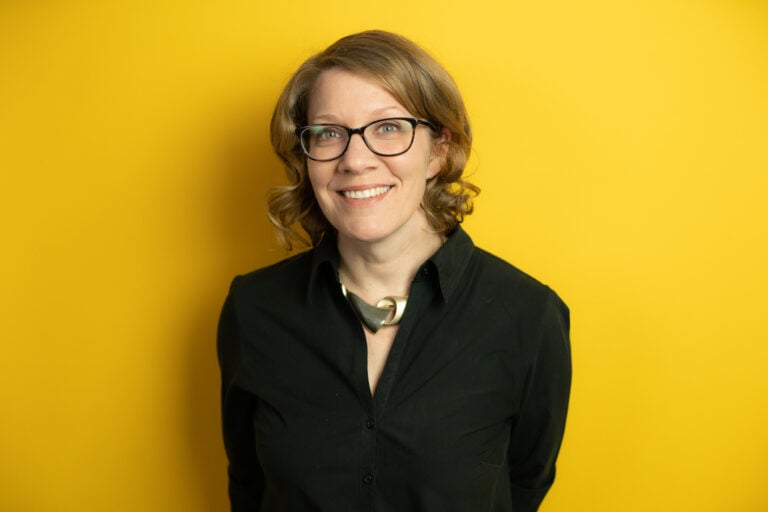On this episode of Innovating Enrollment Success, we explore the challenges of marketing higher education costs while also creating compelling content about the college experience.
Show Notes
Paskill President Jim Paskill and JPL Executive Creative Director Mary Pedersen share their thoughts on what’s possible to change the narrative of cost in enrollment marketing campaigns.
This episode addresses:
- Why institutions need to own their brand stories
- Consistent marketing across the enrollment journey
- Ways to present higher ed’s value beyond outcomes
- Embracing transparency in communicating cost
- Adapting to changes in enrollment marketing
Learn More About Paskill's Brand Strategy & Creative
Transcript
Cathy Donovan [00:00:00]
Hello, and welcome to the Innovating Enrollment Success podcast, where we make space to discuss the marketing trends that are impacting colleges and universities, as well as influencing prospective students and families.
Cost continues to be the number one concern surrounding higher education enrollment marketing today.
We know that the investment in college has long been one of the top financial investments a family can make. What’s changed is the growing dialogue of high tuition and hidden fees in a world where consumers have more access and options than ever before, not to mention a challenging economy and the collective questioning of the value of a college degree.
I’m Cathy Donovan, agency marketing director at Paskill, a higher education enrollment marketing firm that has been shaping the future of institutions since 1986. Today, I’m joined by two marketing leaders in our agency that have deep experience with brand strategy, creative and enrollment marketing.
Mary Pedersen leads a large team of creative strategists, writers, and visual content producers to ensure results-focused, innovative solutions are being crafted. She has a passion for pushing the boundaries of imagination, challenging strategists for insights and employing new technology in unexpected ways. Her background includes a diverse range of international, national and regional client experiences in a range of industries.
Her higher ed work includes Point Park University, Central Penn College, Penn State’s Dickinson Law and Harrisburg University, to name a few. Mary also teaches communication design at the collegiate level at institutions like Messiah University, Harrisburg Area Community College, and her alma mater, Kutztown University.
Jim Paskill has been involved with every major Paskill account during the past 30 years, positively impacting undergraduate and graduate enrollment for hundreds of partners, including private and public institutions, faith-based, health sciences, and community colleges. Jim knows what works and what doesn’t in enrollment marketing, including admissions communications, brand research and messaging, and how to truly measure success in implementing marketing plans.
He’s presented at several higher education marketing conferences, including AMA’s Symposium of the Marketing of Higher Education, on Diversifying Enrollment with the United States Coast Guard Academy, and at NCMPR’s National Conference on Reinvigorated Recruiting with community college partner Three Rivers College.
Welcome, Mary and Jim.
Mary Pedersen:
Thanks, Cathy. Great to be here.
Jim Paskill:
Thank you.
Cathy Donovan:
So before we jump into this complex issue, I would like to just get your takes on what innovating enrollment success means to each of you. Jim, will you lead us off here?
Jim Paskill:
Yeah, sure. Thank you, Cathy. You know, for Paskill, it’s really about continuing to move the needle for our clients and helping them reach their goals in an enrollment marketing environment that’s continuing to reinvent itself.
I think we also have to remember that innovation isn’t just about utilizing the latest technology or paid media property to help us achieve those goals. It’s really about finding new ways to tell our story and developing relationships with families during that college search process. And, of course, a big part of that is how we talk about cost and the value of higher education.
Cathy Donovan:
Thanks Jim.
Jim Paskill:
You’re welcome.
Cathy Donovan:
Mary, you oversee many creatives at the agency and a range of clients. Can you talk a little bit about how your team infuses issues you know the consumer wants to learn about costs, but without compromising the integrity of the brand or the energy of a campaign?
And, also, because you teach college students, how does that experience shape your views of the cost of higher education?
Mary Pedersen:
Oh, that’s a great question. Well, I think it all starts with knowing the brand’s or the school’s unique and ownable story. One that makes a promise to the consumer, one that’s authentic and helpful, right?
A story that only you can say. And the creative, if it’s done well, that adds energy to the story. It breaks through and it stops the right audience. And I think in any industry, in any market in America today, value is a part of that story.
We often talk about how to infuse cost in terms of messaging hierarchy. What do you lead with, right? Whether it’s with your ownable difference or with your price tag, you need to be able to follow up on what you lead with and deliver context. You need to be able to talk about reasons to believe that your message is true and what the next steps are if you’re interested.
And I think when it comes to higher ed, value is an increasing part of colleges’ stories, both in terms of time and money.
You’ve also asked about teaching college students and how that experience has shaped my thinking on this topic. I teach communication design, and I’m very aware that the students I teach are, for the most part, very goal oriented. They came to school wanting to be a designer in some industry or to create visual work for brands or clients.
That differs from fine arts, of course. So, most of my students could answer the question, what do they expect to be doing after college? What kind of career do they anticipate?
And over my experience, I’ve taught a variety of classes, some that are focused on just learning design programs and production techniques. And I’ve taught those that really hinge on conceptual thinking. What I’ve seen in both types of classes is an anticipation of what a student is going to need for their career. And it’s just as important to their everyday experience as is learning to develop their own creative voice.
I just want to mention, too, I also tend to teach more senior level classes where students are often closer to internships or graduation or first job.
And over the years, the number of questions that I get in class about salary and what it’s like to work day to day as a creative, those have doubled—easily—so much so that I’ve now built it into my curriculums.
Cathy Donovan:
So Jim, as president of Paskill and a longtime enrollment marketer with hundreds of higher ed partners, why is costs such a complex issue for the higher ed marketplace right now?
Jim Paskill:
I think cost, Cathy, has always been a complex issue for higher education. And I think, really, if you look at it, higher education only has themselves to blame for it. In terms of transparency, if you look at higher education and pricing, they’re one of the least transparent large industries in the country.
Right now, the discount rate for a private non-profit college is hovering somewhere around 50, 56 percent. So, the reality is that the tuition figures that schools publish typically are not going to be paid by the vast majority of the families out there. So I think that’s one reason that colleges and universities have a difficult time talking about pricing, because the price isn’t necessarily the price.
And, I think, just take a look at any college website and see how far you have to dig even to find tuition and fees. I think that’s testament to the fact that it is not a comfortable subject, because it for so long has not been transparent.
And I think another issue, another component, of this is now the media has really latched hold of this topic. They’re really looking at college and university education from the standpoint of ROI. Is a college education worth it when you compare what these graduates are going to be making, you know, five years, 10 years, 15 years out of school? Is the education worth the cost? So I think that the media’s focus on this topic has really shown a light on the subject, and parents and families are really starting to ask that question. And, unfortunately, I think most colleges and universities are ill equipped to address those issues.
Cathy Donovan:
So, for Mary first, I’m curious what role storytelling plays in marketing cost effectiveness and how colleges can craft narratives that resonate with these audiences?
Mary Pedersen:
Sure. That’s a great question, because in any enrollment campaign, in any marketing initiative, storytelling is everything. Just to build on what Jim is saying, we say all the time, if you want your audience to have a preference for you, they have to see a difference in what you do and who you are.
Otherwise, you risk the decision coming down to familiarity or availability. But when it’s done well, the right story can help students and families elect in or elect out. And it’s not just one brand line or one campaign that can accomplish all of that. Especially in higher ed, the full story has to include the experience and the myriad of touchpoints along a student’s journey.
So you should be connecting your campaign messages and themes to the work of your admissions counselors, to what’s being said on social media. Cost is being spoken about in those forums. It makes sense to connect your campaign, your site to those same themes. I think, too, where in the narrative you talk about cost, that is really important, right?
How easy it is to get answers about cost? That’s often related to the perception students and families have about how helpful will the school be in my full experience. How helpful will it be to my life beyond college?
I think also it’s how you talk about it. I think that’s key. You know, some colleges may benefit from, to Jim’s point, just being very straight facts and figures. And others? It’s more advantageous to market education’s total value because your audiences are different. They’re coming from different places. Some have first-generation students, others need help walking through financial assistance. Showing that you understand the motivations and the realities of your students’ and families’ individual experiences, that can be a win. Not just in higher ed, that’s any market.
Jim Paskill:
Yeah. That’s a great point, Mary. And I think something else, to follow up on that, is that the discussion about value and what higher education brings to a student can’t just start and end with career or job preparedness. And that, as I mentioned earlier, is something the media has really latched onto and is tying costs to earnings.
And I think there’s more to a four-year college education, especially for a traditional undergraduate student, than just the academic side of it. These are very formative years in a young person’s life between 18 and 21. And college can offer a lot more to that student in life skills such as budgeting, time management, how to be a good global citizen – all of these things are learned at good colleges.
And there are a lot of them out there that do a terrific job with this. That has to be part of that value discussion, that storytelling, as you said. And I think very few colleges really address that in a big way. They get hung up in answering that value question as it only relates to job and career placement and earnings. And I think they need to tell the broader story.
Cathy Donovan:
I’d like to learn a little bit about, are there any schools that are doing this well or are there any industries that higher ed could learn from?
Jim Paskill:
You know, I’d like to rattle off a half a dozen schools we work with that do a terrific job, but I think all schools can use some improvement in this area.
And I think, as I said, within higher education, talking about cost has always been kind of behind the curtain. It isn’t something that was readily discussed. In some cases, it has been more common practice, with two-year institutions, community colleges, where it is a very affordable cost, and you don’t have the huge discount rates that you do in the four-year institutions.
They’ve been more transparent in it. And it’s very much a means to an end for these students. But, with four-year institutions, especially some of the more prestigious and selective four-year institutions, you have things like “perceived value.” And if we talk about price and the discount, well, that’s kind of cheapening that school in their own minds.
So, it really is an area that a lot of schools could do a better job at. And I’d be hard pressed to point out one that’s doing it good in all areas.
Mary Pedersen:
You know what I find interesting about that, Jim? You were talking about the perception of value. I think we also have to talk about how cost plays into the perception of quality.
For better or worse, students and families, we’re all trained consumers in a capitalist market, right? We recognize the difference between something that’s perceived as a bargain basement sale. And we also all know that adage, “If you have to ask, you can’t afford it.”
This is a huge opportunity for schools to be transparent, to be authentic, to take students, when appropriate, by the hand and lead them through this conversation with helpful information. And I think it too, it goes back to messaging hierarchy. If you talk about the perceived value as a much broader story, you have a much more interesting place to begin from. And also something to build from.
Cathy Donovan:
So Jim, when you talk about these intangibles of a college experience that are difficult to put out in an advertising campaign or on a website, how can agency partners like Paskill work with institutions to really cultivate what are those intangibles that make your college experience worth the value of the cost?
Jim Paskill:
Yeah, it’s a great question, Cathy. And one of the services that Paskill for decades has been very well known for is our staff development and training. We work directly with the admissions counselors. And I think that’s where these stories need to really take root. It’s those conversations between the admissions counselors and the families where the admission counselor is telling their story.
And with a lot of our clients—a lot of those admissions counselors, they’re alums at the school that they’re working with. So they have the opportunity to tell how they experienced – beyond just the academic side, which is so important, and I’m not discounting that—but all of those other intangibles, as you mentioned, how it touched their lives, how it shaped them into the person they are. That’s a story that will resonate with parents and even with the 18-year-old. So that’s where it begins. It’s very hard to tell those stories on a website, in a publication, even in a blog. It’s much easier when it’s a one-on-one conversation between the counselor and the family.
Mary Pedersen:
Jim, can I build on that? Only because, in order to get to the admissions counselor, you have to do a really great job in the upfront. You have to be able to differentiate in order to get them into that conversation. And so one of the mandatories, honestly, with beginning any creative strategy has to be around: What makes you unique? What can your college do that maybe another would not? Is there something unique about the ideal student for your university that you can articulate and really reach out and connect with both that student as well as their family? Really pushing ourselves. And I’d encourage bravery here, for sure. Anything that we can do to make sure that you’re telling the story of changing the game for the right student, that is important from the very first communication all the way through that admissions counselor story.
Cathy Donovan:
It also sounds like a good formula for a strong brand. That brand has to resonate with what is true about that institution, and then have all of the folks that support it really embody it.
Is there any connection here with a strong brand and where value fits into that. I know brand messaging is difficult, but can we talk a little bit about that? Brand and cost?
Jim Paskill:
Yeah. I think a lot of schools still get hung up on trying to differentiate themselves in ways that don’t make them different at all.
14 to 1 student faculty ratio, or faculty that really care, or academic programs that lead to careers… These are all things that schools talk about in an effort to distinguish themselves, but, in essence, all they are is sounding like everybody else.
I think those schools that truly can change lives and can demonstrate how they’re changing lives through the actual people themselves—the students, the alumni—telling those stories, that’s a way that they can distinguish themselves. And I think schools get far too hung up on the features of the school, the facilities, the programs, and they miss that larger picture of literally how they’re changing lives every day. And I think that is a tremendous brand attribute to have.
Cathy Donovan:
So for both of you, any predictions about how this cost conversation will continue to impact higher education?
Jim Paskill:
Oh, college is going to be free in a few years. Don’t worry about it. (Laughter)
Cathy Donovan:
Okay, great. That works out.
Jim Paskill:
No, cost is going to continue to be a large, important factor in the college selection process. Thirty-five years ago, it was ranked either one or two, typically behind reputation of the school. Today, it’s about the same. So even when college was much more affordable, relatively more affordable, it was an important issue. It’s an important issue. Now it’s going to be an important issue going forward.
But I think the difference is we have a more educated consumer. We have families that understand what the discount rate is, that will look into the grants and scholarships that are available, and will really dig into the pricing, versus maybe 15, 20 years ago where, okay, well, that’s the price and that’s what I’m going to pay for my child. Whereas now families are shopping, they’re playing one school off of another.
It’s become, as I said, a much more educated consumer, and it is much more of a price and tuition and fees discussion than it was even 5, 10 years ago.
Mary Pedersen:
I think too that the narrative in the market is that, for better or worse, that confidence in the value of higher education, we see it decreasing, the confidence decreasing, and all predictions are that that’s going to continue to be the reality for some time.
So it is time to really put your money where your mouth is, actually. To act in a way that demonstrates why it is that you’re right for certain students. Showing and speaking to how you’re different as a brand, as an institution, it’s really not just an option anymore. It’s one of the best ways that you can ensure that your narrative lands in all of your communication and in all of your marketing.
Cathy Donovan:
Fantastic. Thank you both for joining me today. Obviously, tuition will be an important factor for students and families for some time. And as marketers, we want to do our part to connect those right fit students to institutions everywhere. Because we believe higher education makes a difference for students, communities, and our world.
For more about Mary and Jim, please see our show notes or find them on social, or if you’d like, reach out to us at Paskill. We’re always grinding on this issue and really curious about how we could always better serve our audiences for the best possible outcomes. Mary and Jim, thank you so much.
Jim Paskill:
Thank you!
Mary Pedersen:
Thank you, Cathy.






